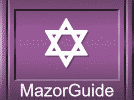|
• The Processional
and the Chuppah Ceremony
• The Processional Music
• The Wedding Party
•
Unterfehren – Guiding the Bride and Groom Down the Aisle
• Candles
• Circling the Groom
• Songs and Prayers of Welcome
• Where to Stand Under the Chuppah
• Remembering Departed Parents
• Gifts Under the Chuppah
The Processional and the Chuppah Ceremony
Grooms set off to the Chuppah first. Why?
halacha spells out several ways to establish a Jewish marriage, and a woman entering a man’s home – alone with the intent to marry – is one of them. With four sides and a roof, the Chuppah is technically a private room. Grooms stand under the Chuppah first to welcome their bride into their “first home.”
Ever since Rebecca offered a chance to turn down the offer to marry Isaac (Genesis 24:58-59), Jewish marriages are predicated on a woman’s consent. A bride approaches her groom and with each step she expresses her willingness to wed.
There are other insights, which can appear to favor the woman’s or the man’s spiritual heights. Instead of viewing the interpretations as pitting feminine over or below male virtues, it is helpful to bear in mind Judaism’s assertion that men and women possess very different soul strengths.
Brides are likened to the Jewish people who were brought toward Mt. Sinai when they received the Torah. Receiving the Torah is a recurring theme of the Jewish wedding ceremony, with the ketubbah standing in for the “marriage contract” between God and the Jewish people.
Each couple has the potential to begin a new world, and the wedding ceremony is peppered with references to Genesis’s account of creation. A spiritual hierarchy puts inanimate object below those that grow, and above those the mobile living creatures. Topping the list are creations that talk – namely humans. Rabbi Aryeh Kaplan notes as the seven days passed, the creations became more and more spiritually refined. Women were given the ability to hold life within them and were created last. Just as God brought Eve to Adam, the bride is brought to her groom.
Music
Each step toward the Chuppah is accompanied by music. Just as the Levites sang and played instruments as the kohen priests performed their holy duties in the Beit Hamikdash, the ancient Temple in Jerusalem. Music that amplifies this sanctity uplifts the ceremony.
Processional music that summons a state of mind is a good choice. In some Chassidic communities the processional always goes with a wordless niggun song. Within those circles, the first notes of the niggun transport listeners to memories of or hopes for their own wedding.
The Wedding Party
Before the bride enters, the rest of the wedding party marches down the aisle. Wedding parties originated as friendly bodyguards. A bride was escorted by family and friends so none – not even mischievous spirits - could keep her from reaching the Chuppah. Appearing with a entourage is a mark of a Very Important Person. Jewish tradition likens the bride and groom to royalty. This may be one of the reasons why bridesmaids and groomsmen have proliferated.
A biblical account of Samson’s marriage to Delilah mentions 30 men who made up the wedding party. The Hebrew term for them is shoshvinim. Since these men are only mentioned as partaking in the wedding feast, it may be more accurate to think of them as special guests rather than modern day best men.
Wedding parties fill a social role. Bridesmaids host bridal showers, buy ugly bridesmaid dresses and warm cold feet. Groomsmen do much the same, except they purchase tacky cummerbunds. The roles of a bridesmaid, best man, flower girl, ring bearer or anything else the glossy wedding magazines have dreamed up are purely for the comfort and pleasure of the newlyweds and fulfill no religious role.
A word on the bridesmaid dresses: Sanctity is so very much a part of the Jewish wedding ceremony that its name is kiddushin, which means “holiness.” Symbol after symbol links the couple to the holiness of creation and the giving of the Torah. Wedding clothes should be selected with this in mind. Standards of modest dress include sleeves that reach the elbows and hems that at least brush the knee. Skip the plunging neckline and backless dress.
Unterfehren – Guiding the Bride and Groom Down the Aisle
We are never alone. In birth, bris, marriage and death, supporting hands of love are called for and given Jewish significance. At a wedding, the unterfehren who walk down the aisle with the bride and groom stand in for the angels were present as Adam married Eve and the angels who flew thick around Mt. Sinai.
Who escorts a bride or groom down the aisle? Jewish customs vary. In some communities, parents linked arms with their child, while other traditions had the mother and mother-in-law surround the bride and the father and father-in-law hold onto the groom. Today, some couples feel more comfortable having good friends or other close relatives walk them down the aisle. Being escorted by a successful married couple, (first marriage for both) is an important omen in some circles.
Unterfehren served a practical purpose. Brides were veiled with heavy, opaque cloth. Without the unterfehren’s steadying presence, a bride would be unable to find the Chuppah.
Candles
Lit candles are carried by the unterfehren, who guide the bride and groom, as they approach the Chuppah. In Jeremiah light and marriage are linked as chief joys: “…the voice of gladness, the voice of the bridegroom, the voice of the bride… the light of the lamp.” (Jeremiah 25:10)
Light is identified with joy. “The Jews had light, and gladness, and joy, and honor.” (Esther 8:16) Candles are a prayer that the couple will find happiness together.
According to other interpretations, candles recall the streaks of lightning that pierced the skies over Mt. Sinai when the Torah was received. (Exodus 19:16) Many commentators liken the giving of the Torah to a wedding between God and the Jewish People. (For instance, the Torah is thought of as the ketubah and the mountain which was said to have stood as a rooftop over the Jewish people (Rashi, Exodus 19:17) was the Chuppah.)
Braided havdalah candles, traditionally lit at the end of Shabbat, are made of many intertwined wicks that flicker like these lightning flashes.
Havdalah candles light with one flame, a radiant symbol of unity. Rendered according to its numeric value, the Hebrew word for candle, “ner,” equals 250. The two candles that surround the bride or the groom total 500. A traditional counting of the body parts of a man is 248, a woman’s 252, totaling (you guessed it) 500. Candles symbolize the two who will be joined in marriage.
Single candles are often used as well. Ensconce in the candles in hurricane glasses so they don’t blow out or dribble hot wax onto hands and dresses.
Circling
Acharon, Acharon Chaviv. “The very last is the most precious.” (Bereshit Rabbah 78:11). Only after the entire wedding party has made it down the aisle does the bride make her appearance. Once the bride reaches the Chuppah, she circles her groom a number of times. Depending on a family’s custom, the bride would be accompanied by her parents, her mother and mother-in-law, or her entire wedding party.
Some find the origin of this custom in Jeremiah 31:21. He forecasts the remarkable nature of the ultimate redemption, the times of
Moshiach, when “the Lord has created a new thing in the earth, a woman shall go around a man.” Various commentators explain as the redemption approaches women will begin courting men. (Now that women have been released from waiting for men to call for a date, some modern thinkers have stated this prophecy has come true, but that’s another discussion for another time.) In any case, brides “court” their husbands and offer hope for the Redemption by circling their grooms.
Marriage creates a spiritual bond between man and woman. Each half of the couple strengthens the other. Women, according to the Gemara, spiritually protect a man from temptation. “A man without a wife is without a wall” (Yebamot 62b). Brides enrobe their husbands-to-be in spiritual fortitude as they walk around their husbands-to-be.
The number of rounds varies, depending on which symbols are drawn on. Three turns represent, among other interpretations, the three basic obligations a husband has to his wife: food, clothing, and sex. Others note the phrase “when a man takes a wife” appears three times in the book of Deuteronomy. Brides remind their grooms of the Torah’s laws that husbands, in particular, must follow.
Seven circuits come to include the seven additional obligations set out by the rabbis: to marry through a ketubah; to pay her medical expenses, to pay for her burial; to ransom her from kidnappers; to support her other children; to support her with proceeds from his estate after his death; and to allow her sons to inherit the settlement amount in the ketubah.
On a spiritual level, the seven turns represent the seven days of creation. The world’s creation is a dominant theme of the Jewish wedding ceremony, because the couple is seen as the beginning of a whole new world. Seven further represented the kabbalistic strengths of the soul. Under the Chuppah, a couple’s prayers pierce the loftiest levels of heaven, all the way through the seventh heaven, which is represented by the seven circles.
As the circuits are turned, the Mi von see-ach song is chanted. “May the one who speaks of the rose among thorns, the affection of lovers, the joy of the beloved, may He bless the groom and the bride.”
“Rose among thorns” is a reference to a passage in the Song of Songs (2:2): “Like a rose among thorns, so is my beloved among the maidens.”
Most Sephardic communities did not adopt this custom.
Songs and Prayers of Welcome
Once everyone is in place two prayers of welcome are chanted to the couple. A cantor can say these words or anyone who can carry a tune.
“Blessed may you be who comes in the name of the Lord. May He, who dwells on high, send His abounding blessing to the groom and bride.”
Where to Stand
Once everyone settles in underneath the Chuppah, the bride stands to the right of the groom. Once again this is the regal nature of the newlyweds dictating custom. Notes the Psalmist: “At your right hand stands the queen” (45:10).
Remembering Departed Parents
Just before the ceremony begins a couple may choose to have the El Maleh Rachamim prayer chanted in memoriam to a parent who did not live to see his or her child stand under the Chuppah.
Gifts Under the Chuppah
According to an old German-Jewish custom, a bride and groom would present each other with burial shrouds as they stood under the Chuppah. To uninitiated ears, it sounds like a morbid gift. One of the thoughts behind the custom is the couple’s new love should last a lifetime.


|







